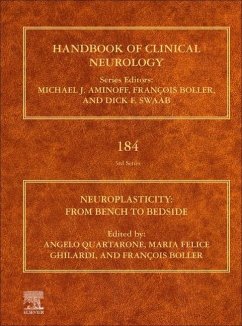Neuroplasticity
From Bench to Bedside Volume 184
Herausgeber: Quartarone, Angelo; Boller, Francois; Ghilardi, Maria Felice
Neuroplasticity
From Bench to Bedside Volume 184
Herausgeber: Quartarone, Angelo; Boller, Francois; Ghilardi, Maria Felice
- Gebundenes Buch
- Merkliste
- Auf die Merkliste
- Bewerten Bewerten
- Teilen
- Produkt teilen
- Produkterinnerung
- Produkterinnerung
Neuroplasticity: From Bench to Bedside, Volume 184 in the Handbook of Clinical Neurology series, provides a comprehensive multidisciplinary guide to neuroplasticity. Sections summarize the basic mechanisms of neuroplasticity, focus on neuroplasticity in movement disorders, discuss brain oscillations in neurological disorders, segue into plasticity in neurorehabilitation, and cover issues of inflammation and autoimmunity in neuroplasticity. The book concludes with a section on neuroplasticity and psychiatric disorders.
Andere Kunden interessierten sich auch für
![Brain and Crime Brain and Crime]() Brain and Crime262,99 €
Brain and Crime262,99 €![Heart and Neurologic Disease Heart and Neurologic Disease]() Heart and Neurologic Disease262,99 €
Heart and Neurologic Disease262,99 €![Intraoperative Neuromonitoring Intraoperative Neuromonitoring]() Intraoperative Neuromonitoring262,99 €
Intraoperative Neuromonitoring262,99 €![The Human Hypothalamus The Human Hypothalamus]() The Human Hypothalamus262,99 €
The Human Hypothalamus262,99 €![Disorders of Emotion in Neurologic Disease Disorders of Emotion in Neurologic Disease]() Disorders of Emotion in Neurologic Disease262,99 €
Disorders of Emotion in Neurologic Disease262,99 €![The Human Hypothalamus The Human Hypothalamus]() The Human Hypothalamus262,99 €
The Human Hypothalamus262,99 €![The Human Hypothalamus The Human Hypothalamus]() The Human Hypothalamus262,99 €
The Human Hypothalamus262,99 €-
-
-
Neuroplasticity: From Bench to Bedside, Volume 184 in the Handbook of Clinical Neurology series, provides a comprehensive multidisciplinary guide to neuroplasticity. Sections summarize the basic mechanisms of neuroplasticity, focus on neuroplasticity in movement disorders, discuss brain oscillations in neurological disorders, segue into plasticity in neurorehabilitation, and cover issues of inflammation and autoimmunity in neuroplasticity. The book concludes with a section on neuroplasticity and psychiatric disorders.
Hinweis: Dieser Artikel kann nur an eine deutsche Lieferadresse ausgeliefert werden.
Hinweis: Dieser Artikel kann nur an eine deutsche Lieferadresse ausgeliefert werden.
Produktdetails
- Produktdetails
- Verlag: Elsevier Science
- Seitenzahl: 534
- Erscheinungstermin: 18. Mai 2022
- Englisch
- Abmessung: 199mm x 269mm x 34mm
- Gewicht: 1660g
- ISBN-13: 9780128194102
- ISBN-10: 0128194103
- Artikelnr.: 62606871
- Herstellerkennzeichnung
- Libri GmbH
- Europaallee 1
- 36244 Bad Hersfeld
- gpsr@libri.de
- Verlag: Elsevier Science
- Seitenzahl: 534
- Erscheinungstermin: 18. Mai 2022
- Englisch
- Abmessung: 199mm x 269mm x 34mm
- Gewicht: 1660g
- ISBN-13: 9780128194102
- ISBN-10: 0128194103
- Artikelnr.: 62606871
- Herstellerkennzeichnung
- Libri GmbH
- Europaallee 1
- 36244 Bad Hersfeld
- gpsr@libri.de
Section I. Introduction
1. Defining neuroplasticity
Section II. Neuroplasticity: Basic Mechanism and Assessment at System Level
2. Basic mechanisms of plasticity and learning
3. Local sleep: a new concept in brain plasticity
4. Sleep and homeostatic control of plasticity
5. Transcranial magnetic stimulation as a tool to induce and explore
plasticity in humans
6. EEG as marker of brain plasticity in clinical applications
7. Tools to explore neuroplasticity in humans: Combining interventional
neurophysiology with functional and structural magnetic resonance imaging
and spectroscopy
8. Metabolic imaging and plasticity
Section III. Neuroplasticity in Movement Disorders
9. Parkinson's disease: Alterations of motor plasticity and motor learning
10. Alpha-synuclein and cortico-striatal plasticity in animal models of
Parkinson disease
11. Plasticity, genetics, and epigenetics in L-DOPA-induced dyskinesias
12. Non-invasive neuromodulation in Parkinson's disease: Neuroplasticity
implication and therapeutic perspectives
13. Plasticity, genetics and epigenetics in dystonia: An update
14. Neuroplasticity in dystonia: Motor symptoms and beyond
Section IV. Brain Oscillations in Neurological Disorders
15. General principles of brain electromagnetic rhythmic oscillations and
implications for neuroplasticity
16. Noninvasive brain stimulation and brain oscillations
17. Brain oscillatory dysfunctions in dystonia
18. Brain oscillations and Parkinson disease
19. Adaptive deep brain stimulation: Retuning Parkinson's disease
Section V. Plasticity and Rehabilitation
20. Biomarkers of plasticity for stroke recovery
21. New tools for shaping plasticity to enhance recovery after stroke
22. Neuroplasticity of spinal cord injury and repair
23. Reward and plasticity: Implications for neurorehabilitation
24. Rehabilitation in movement disorders: From basic mechanisms to clinical
strategies
25. Rehabilitation of visual perception in cortical blindness
26. The role of plasticity in the recovery of consciousness
27. Plasticity of the language system in children and adults
Section VI. Inflammation, Autoimmunity, and Plasticity
28. Synaptic dysfunction in early phases of Alzheimer's disease
29. T-cells, alpha-synuclein, and Parkinson disease
30. Multiple Sclerosis: Inflammation, autoimmunity and plasticity
Section VII. Plasticity in Cognitive and Psychiatric Disorders
31. Alzheimer disease and neuroplasticity
32. From chronic stress and anxiety to neurodegeneration: Focus on
neuromodulation of the axon initial segment
33. Shaping plasticity with non-invasive brain stimulation in the treatment
of psychiatric disorders: Present and future
1. Defining neuroplasticity
Section II. Neuroplasticity: Basic Mechanism and Assessment at System Level
2. Basic mechanisms of plasticity and learning
3. Local sleep: a new concept in brain plasticity
4. Sleep and homeostatic control of plasticity
5. Transcranial magnetic stimulation as a tool to induce and explore
plasticity in humans
6. EEG as marker of brain plasticity in clinical applications
7. Tools to explore neuroplasticity in humans: Combining interventional
neurophysiology with functional and structural magnetic resonance imaging
and spectroscopy
8. Metabolic imaging and plasticity
Section III. Neuroplasticity in Movement Disorders
9. Parkinson's disease: Alterations of motor plasticity and motor learning
10. Alpha-synuclein and cortico-striatal plasticity in animal models of
Parkinson disease
11. Plasticity, genetics, and epigenetics in L-DOPA-induced dyskinesias
12. Non-invasive neuromodulation in Parkinson's disease: Neuroplasticity
implication and therapeutic perspectives
13. Plasticity, genetics and epigenetics in dystonia: An update
14. Neuroplasticity in dystonia: Motor symptoms and beyond
Section IV. Brain Oscillations in Neurological Disorders
15. General principles of brain electromagnetic rhythmic oscillations and
implications for neuroplasticity
16. Noninvasive brain stimulation and brain oscillations
17. Brain oscillatory dysfunctions in dystonia
18. Brain oscillations and Parkinson disease
19. Adaptive deep brain stimulation: Retuning Parkinson's disease
Section V. Plasticity and Rehabilitation
20. Biomarkers of plasticity for stroke recovery
21. New tools for shaping plasticity to enhance recovery after stroke
22. Neuroplasticity of spinal cord injury and repair
23. Reward and plasticity: Implications for neurorehabilitation
24. Rehabilitation in movement disorders: From basic mechanisms to clinical
strategies
25. Rehabilitation of visual perception in cortical blindness
26. The role of plasticity in the recovery of consciousness
27. Plasticity of the language system in children and adults
Section VI. Inflammation, Autoimmunity, and Plasticity
28. Synaptic dysfunction in early phases of Alzheimer's disease
29. T-cells, alpha-synuclein, and Parkinson disease
30. Multiple Sclerosis: Inflammation, autoimmunity and plasticity
Section VII. Plasticity in Cognitive and Psychiatric Disorders
31. Alzheimer disease and neuroplasticity
32. From chronic stress and anxiety to neurodegeneration: Focus on
neuromodulation of the axon initial segment
33. Shaping plasticity with non-invasive brain stimulation in the treatment
of psychiatric disorders: Present and future
Section I. Introduction
1. Defining neuroplasticity
Section II. Neuroplasticity: Basic Mechanism and Assessment at System Level
2. Basic mechanisms of plasticity and learning
3. Local sleep: a new concept in brain plasticity
4. Sleep and homeostatic control of plasticity
5. Transcranial magnetic stimulation as a tool to induce and explore
plasticity in humans
6. EEG as marker of brain plasticity in clinical applications
7. Tools to explore neuroplasticity in humans: Combining interventional
neurophysiology with functional and structural magnetic resonance imaging
and spectroscopy
8. Metabolic imaging and plasticity
Section III. Neuroplasticity in Movement Disorders
9. Parkinson's disease: Alterations of motor plasticity and motor learning
10. Alpha-synuclein and cortico-striatal plasticity in animal models of
Parkinson disease
11. Plasticity, genetics, and epigenetics in L-DOPA-induced dyskinesias
12. Non-invasive neuromodulation in Parkinson's disease: Neuroplasticity
implication and therapeutic perspectives
13. Plasticity, genetics and epigenetics in dystonia: An update
14. Neuroplasticity in dystonia: Motor symptoms and beyond
Section IV. Brain Oscillations in Neurological Disorders
15. General principles of brain electromagnetic rhythmic oscillations and
implications for neuroplasticity
16. Noninvasive brain stimulation and brain oscillations
17. Brain oscillatory dysfunctions in dystonia
18. Brain oscillations and Parkinson disease
19. Adaptive deep brain stimulation: Retuning Parkinson's disease
Section V. Plasticity and Rehabilitation
20. Biomarkers of plasticity for stroke recovery
21. New tools for shaping plasticity to enhance recovery after stroke
22. Neuroplasticity of spinal cord injury and repair
23. Reward and plasticity: Implications for neurorehabilitation
24. Rehabilitation in movement disorders: From basic mechanisms to clinical
strategies
25. Rehabilitation of visual perception in cortical blindness
26. The role of plasticity in the recovery of consciousness
27. Plasticity of the language system in children and adults
Section VI. Inflammation, Autoimmunity, and Plasticity
28. Synaptic dysfunction in early phases of Alzheimer's disease
29. T-cells, alpha-synuclein, and Parkinson disease
30. Multiple Sclerosis: Inflammation, autoimmunity and plasticity
Section VII. Plasticity in Cognitive and Psychiatric Disorders
31. Alzheimer disease and neuroplasticity
32. From chronic stress and anxiety to neurodegeneration: Focus on
neuromodulation of the axon initial segment
33. Shaping plasticity with non-invasive brain stimulation in the treatment
of psychiatric disorders: Present and future
1. Defining neuroplasticity
Section II. Neuroplasticity: Basic Mechanism and Assessment at System Level
2. Basic mechanisms of plasticity and learning
3. Local sleep: a new concept in brain plasticity
4. Sleep and homeostatic control of plasticity
5. Transcranial magnetic stimulation as a tool to induce and explore
plasticity in humans
6. EEG as marker of brain plasticity in clinical applications
7. Tools to explore neuroplasticity in humans: Combining interventional
neurophysiology with functional and structural magnetic resonance imaging
and spectroscopy
8. Metabolic imaging and plasticity
Section III. Neuroplasticity in Movement Disorders
9. Parkinson's disease: Alterations of motor plasticity and motor learning
10. Alpha-synuclein and cortico-striatal plasticity in animal models of
Parkinson disease
11. Plasticity, genetics, and epigenetics in L-DOPA-induced dyskinesias
12. Non-invasive neuromodulation in Parkinson's disease: Neuroplasticity
implication and therapeutic perspectives
13. Plasticity, genetics and epigenetics in dystonia: An update
14. Neuroplasticity in dystonia: Motor symptoms and beyond
Section IV. Brain Oscillations in Neurological Disorders
15. General principles of brain electromagnetic rhythmic oscillations and
implications for neuroplasticity
16. Noninvasive brain stimulation and brain oscillations
17. Brain oscillatory dysfunctions in dystonia
18. Brain oscillations and Parkinson disease
19. Adaptive deep brain stimulation: Retuning Parkinson's disease
Section V. Plasticity and Rehabilitation
20. Biomarkers of plasticity for stroke recovery
21. New tools for shaping plasticity to enhance recovery after stroke
22. Neuroplasticity of spinal cord injury and repair
23. Reward and plasticity: Implications for neurorehabilitation
24. Rehabilitation in movement disorders: From basic mechanisms to clinical
strategies
25. Rehabilitation of visual perception in cortical blindness
26. The role of plasticity in the recovery of consciousness
27. Plasticity of the language system in children and adults
Section VI. Inflammation, Autoimmunity, and Plasticity
28. Synaptic dysfunction in early phases of Alzheimer's disease
29. T-cells, alpha-synuclein, and Parkinson disease
30. Multiple Sclerosis: Inflammation, autoimmunity and plasticity
Section VII. Plasticity in Cognitive and Psychiatric Disorders
31. Alzheimer disease and neuroplasticity
32. From chronic stress and anxiety to neurodegeneration: Focus on
neuromodulation of the axon initial segment
33. Shaping plasticity with non-invasive brain stimulation in the treatment
of psychiatric disorders: Present and future








